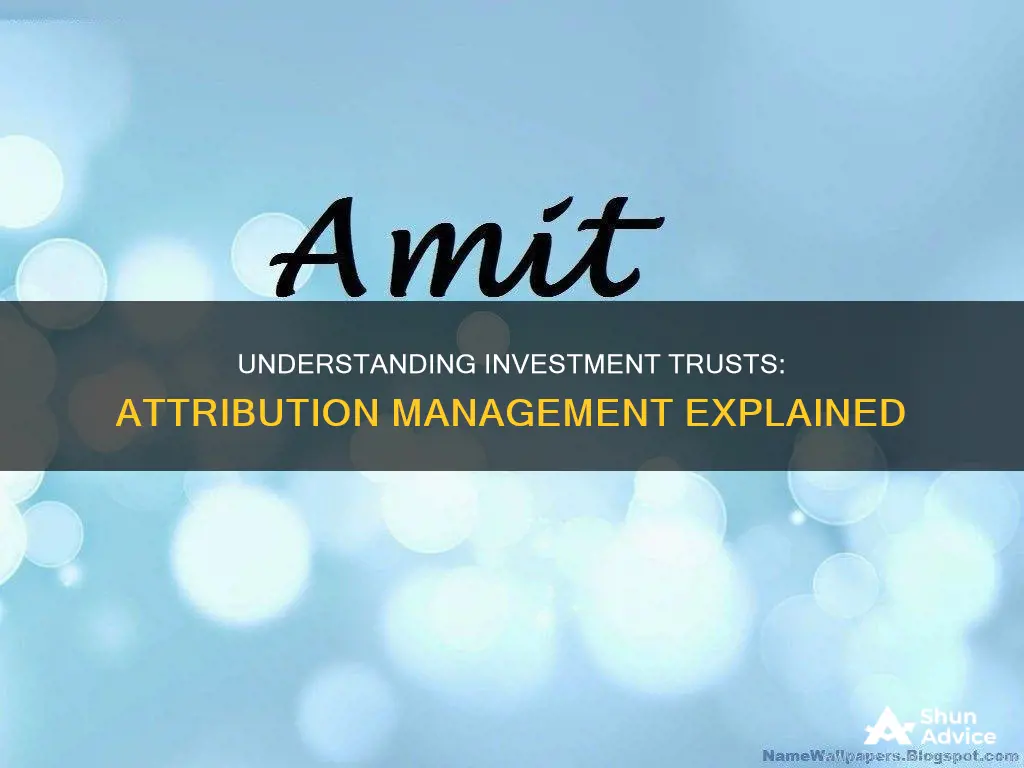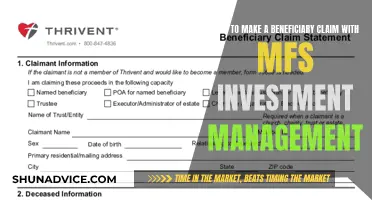
An Attribution Managed Investment Trust (AMIT) is a managed investment trust that has elected to apply the AMIT regime for taxation. The AMIT regime is a system for the taxation of eligible managed funds, allowing AMITs to use an attribution method of tax. This method provides greater certainty for trustees and beneficiaries by aligning the commercial and tax consequences of the trust's activities. To be eligible to apply the AMIT regime, a trust must satisfy certain requirements, including having clearly defined rights to income and capital for its members. Once a trust elects to become an AMIT, the choice is irrevocable, and it will remain an AMIT as long as it maintains its eligibility.
What You'll Learn

AMITs can use an attribution method of tax
The Attribution Managed Investment Trust (AMIT) is a taxation system for eligible managed funds. AMITs can use an attribution method of tax, which replaces the previous present entitlement to income method. This new tax system provides AMITs with greater certainty and reduces complexity and the compliance burden.
The attribution method works by aligning the commercial and tax consequences of the activities of a managed investment trust (MIT). It provides a flow-through of income and tax offset amounts with particular tax characteristics. This allows AMITs to make cash distributions to unitholders, where the cash paid can differ from the tax components attributed as part of that distribution. This results in corresponding adjustments to the tax cost base, which represents the original value of an investment.
For example, if a cash distribution is greater than the attributed taxable amount, the difference will lead to a decrease in the cost base of the units for that year. Conversely, if the cash distribution is less than the attributed taxable amount, the difference will result in an increase in the cost base of the units. This adjustment process continues for the life of the investment, with potential variations in cash distributions and tax attributions from year to year.
The AMIT regime also provides certainty that AMITs will be treated as fixed trusts for tax purposes. This means that members of the AMIT are treated as having a vested and indefeasible interest in a share of the income and capital throughout the income year. Additionally, AMITs can carry forward under- and over-estimates of tax amounts into the discovery income year without adverse tax consequences in most cases.
To be eligible to apply the AMIT regime, a trust must satisfy certain criteria, including being a MIT, having members with clearly defined rights to income and capital, and making an irrevocable choice to adopt the new system. Once a trust becomes an AMIT, it cannot revoke this choice but can cease to be an AMIT if it no longer meets the eligibility requirements.
Investing in Apollo Global Management: A Comprehensive Guide
You may want to see also

AMITs are deemed fixed trusts
AMITs, or Attribution Managed Investment Trusts, are deemed fixed trusts for income tax purposes. This means that an AMIT member is treated as having a vested and indefeasible interest in a share of the income and capital of the AMIT throughout the income year.
The concept of a "fixed trust" is crucial in the context of AMITs. A fixed trust is a type of trust where the beneficiaries' entitlements to the trust's income and capital are clearly defined and remain unchanged during the trust's existence. This is in contrast to a "discretionary trust," where the trustee has the discretion to determine how the trust's income and capital will be distributed among the beneficiaries.
In the case of an AMIT, the members must have 'clearly defined interests' in the income and capital of the trust. This means that the rights of the members to income and capital arising from their membership interests must be unambiguous and set out in the trust's constituent documents. These interests may vary depending on the class of membership, but the overall principle of clear definition must be met.
The treatment of AMITs as fixed trusts provides several benefits. Firstly, it offers certainty regarding the ability of AMITs to carry forward and deduct tax losses. By satisfying the 'fixed trust' loss integrity rules, AMITs can ensure that imputation credits flow to their members. This addresses an area of uncertainty and risk for trustees and responsible entities, as many trusts with unitized interests may not meet the strict interpretation of fixed trust provisions by tax authorities.
Furthermore, the deemed fixed trust status of AMITs allows for the application of codified 'unders and overs' rules. These rules provide additional tax certainty and reduce compliance costs for AMITs. They address errors in distributions by increasing or decreasing subsequent distributions to correct the error, providing a legislative framework that was previously lacking.
Planning Savings and Investments: Strategies for Financial Freedom
You may want to see also

AMITs can carry forward under- and over-estimates of tax
The Attribution Managed Investment Trust (AMIT) is a taxation system for eligible managed funds. An eligible managed investment trust (MIT) may elect to apply the AMIT regime for the taxation of MITs. Those that choose to apply the new tax system are referred to as AMITs.
The AMIT regime allows AMITs to use an attribution method of tax, which replaces the existing present entitlement to income method in Division 6 of the ITAA 1936. This provides greater certainty for trustees and beneficiaries of MITs by aligning the commercial and tax consequences of the activities of a MIT. It also allows for the flow-through of income and tax offset amounts with particular tax characteristics.
Under the AMIT regime, AMITs can carry forward under- and over-estimates of tax amounts into the discovery income year, generally without adverse tax consequences. This is because trustees of MITs can experience difficulty in obtaining final information to allow them to calculate the income and net income of the trust within a reasonable time at the end of each financial year. As a result, they may need to estimate the amounts to report to both the tax office and their members by the required reporting dates.
If a revision occurs, the amounts initially reported to members may overstate or understate the correct amount of their share of the net income of the trust. Before the error is identified, members may have already included the incorrect amounts in their income tax returns. For AMITs, these "unders and overs" can be dealt with in the income year in which they are discovered, called the 'discovery year', rather than the income year to which they relate, called the 'base year'.
If there is an under- or over-estimation of a particular character in an income year, the trustee will need to reconcile the amount in the discovery year or revise the character amount in the base year. It is up to the trustee of an AMIT to determine how to reconcile unders and overs – by either reissuing AMMA statements for the base year or making adjustments to the trust components of particular characters in the discovery year.
Creating a Portfolio: Investing Cash for Beginners
You may want to see also

AMITs can make cash distributions to unitholders
An Attribution Managed Investment Trust (AMIT) is a managed investment trust that has made an irrevocable election to apply the new AMIT regime. The AMIT regime is a taxation system for eligible managed funds.
When a cash distribution is greater than the attributed taxable amount, the difference results in a decrease in the cost base of the units for that year. This is referred to as an AMIT Cost Base Net Amount – Excess on the AMMA statement. Conversely, when a cash distribution is less than the attributed taxable amount, the difference results in an increase in the cost base of the units for that year, referred to as an AMIT Cost Base Net Amount – Shortfall on the AMMA statement.
For example, let's assume Mary has purchased $10,000 worth of units in an AMIT fund. In the first financial year, she receives a cash distribution of $400. When referring to her first annual tax statement, Mary can see that of the $400 cash distribution, only $300 is taxable income attributed to her. This $300 is the amount that is assessable for her payment of tax in Year 1. The remaining $100 is shown on her AMMA statement as a non-attributable amount, resulting in a decrease in the cost base of her investment.
As Mary's cash distribution is greater than the attributed amount, the excess of $100 reduces the tax cost base of her units in the AMIT by $100. In this case, her initial tax cost base of $10,000 would be reduced to $9,900 at the end of Year 1. If Mary were to sell her units now, the capital gain or loss would be calculated using her adjusted cost base at the end of Year 1, resulting in a lower taxable gain or higher loss.
In the following year, Mary receives another cash distribution of $400, but this time the attributed taxable amount is $600. The full $600 is assessable for her payment of tax in Year 2. The additional $200 results in an uplift in Mary's tax cost base, added to the adjusted tax cost base from Year 1, now totalling $10,100.
Over the life of an investment in an AMIT, the net difference between cash distributions and attributed amounts equals the total tax cost base adjustments. This means that any difference between cash distributions and tax attributions triggers tax cost base adjustments annually, resulting in corresponding adjustments to capital gains or losses on the sale of the investment.
In summary, while AMITs can make cash distributions to unitholders that differ from the attributed taxable amounts, these differences result in adjustments to the tax cost base, impacting the calculation of capital gains or losses when the units are sold.
Strategies for Taking Control of Your Investment Portfolio
You may want to see also

AMITs prevent double taxation
Attribution Managed Investment Trusts (AMITs) are a taxation system for eligible managed funds. AMITs can make cash distributions to unitholders, where the cash paid can differ from the tax components attributed as part of the distribution. This can result in a corresponding adjustment to the tax cost base and the introduction of a capital gains tax (CGT) event cost base uplift.
Double taxation occurs when taxes are levied twice on a single source of income. This can happen when income is taxed at both the corporate and personal level, or by two different nations. For example, corporations pay taxes on their annual earnings, and if they later pay out dividends to shareholders, those shareholders may have to pay income tax on this distribution, resulting in double taxation.
AMITs address this issue by allowing adjustments to the cost base. If a cash distribution is greater than the attributed taxable amount, the difference results in a decrease in the cost base of the units for that year. Conversely, if the cash distribution is less than the attributed taxable amount, the difference results in an increase in the cost base of the units for that year.
The AMIT regime also provides greater clarity and certainty associated with the tax treatment of distributions and the character of income and capital. It removes the potential for double taxation that may arise from mismatches between the amount distributed and the taxable income of the AMIT.
Dave Ramsey's Recommended Investment Portfolio: A Guide
You may want to see also
Frequently asked questions
An Attribution Managed Investment Trust (AMIT) is a managed investment trust that has made an irrevocable election to apply the new AMIT regime.
The AMIT regime was introduced to provide AMITs with certainty and to reduce complexity and the compliance burden. Prior to the introduction of the AMIT regime, trusts with different characteristics were subject to the same set of tax laws.
The AMIT regime allows AMITs to use an attribution method to allocate taxable income to unitholders, provides certainty that the AMIT is treated as a fixed trust for tax purposes, and provides access to a legislated 'unders and overs' regime to determine the attributable taxable components to unitholders.
To be eligible to apply the new tax system for AMITs, a trust must satisfy the following requirements: the trust must be a MIT for the income year, the members of the trust must have clearly defined rights to income and capital of the trust during the income year, and the trustee must make an irrevocable choice to apply the new system.







